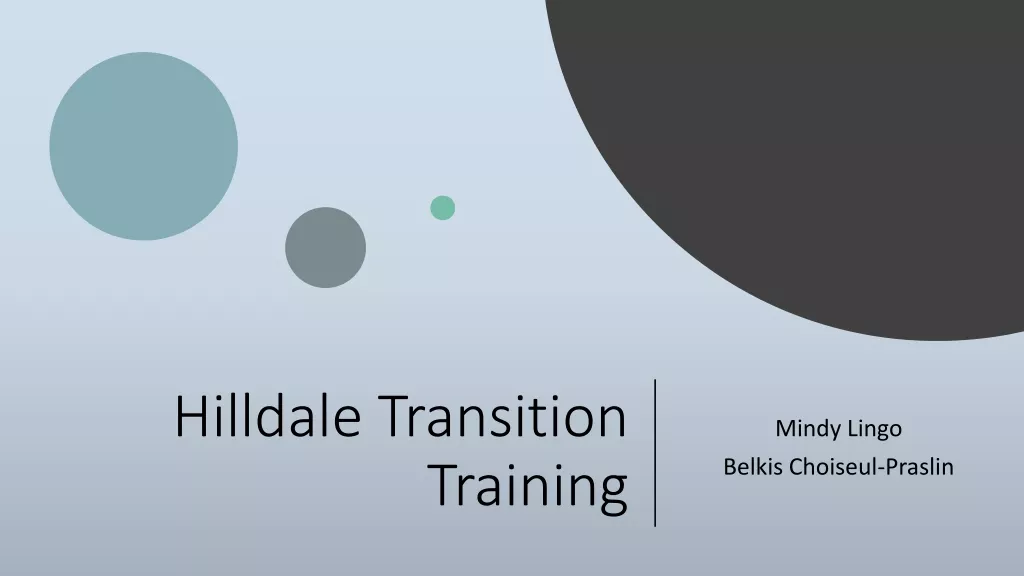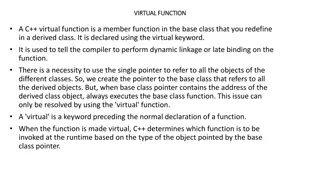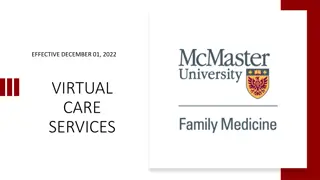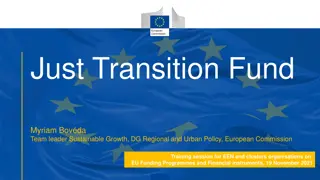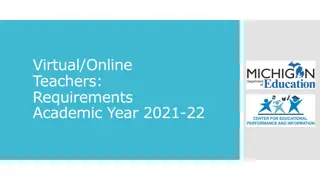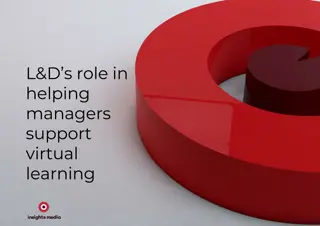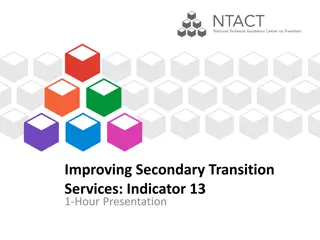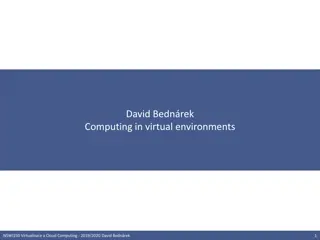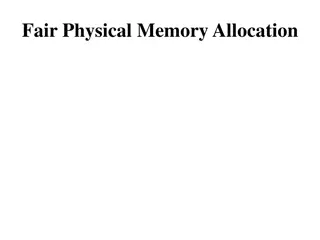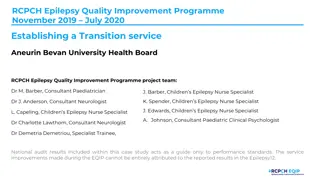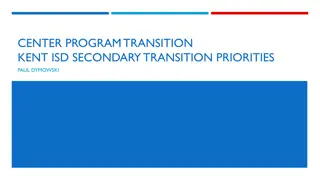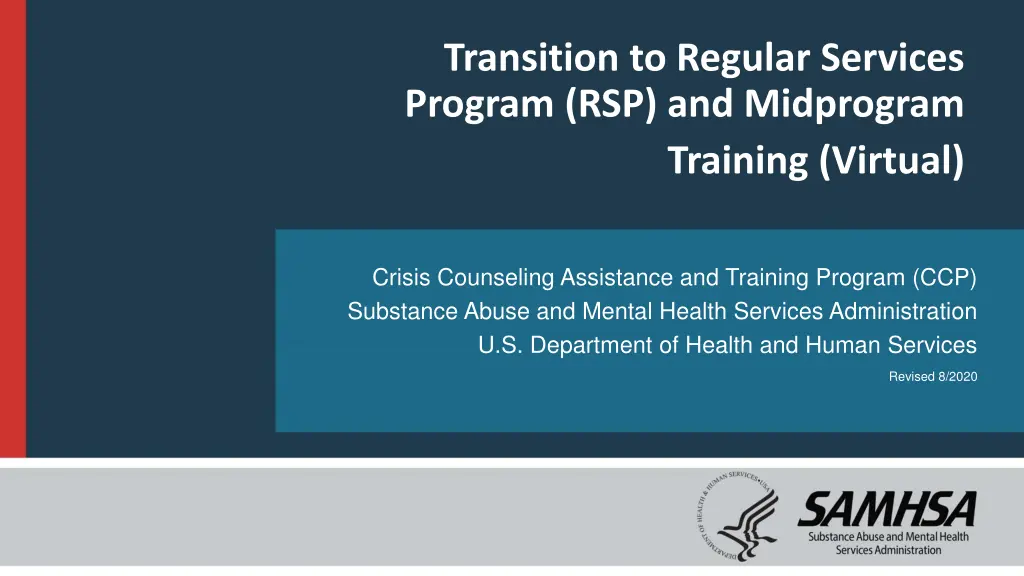
Enhancing Training Experience with RSP and CCP Programs
Explore the transformative programs - Regular Services Program (RSP) and Crisis Counseling Assistance Program (CCP) - aimed at mental health support and training. Engage in interactive sessions, breakout rooms, and activities to boost learning. Participate in a virtual environment for efficient training delivery, especially during the COVID-19 pandemic. Share introductions, fun activities, and preferences to create an inclusive learning atmosphere. Utilize technological tools for seamless communication and support. Start your training journey with engaging polls and insightful discussions.
Download Presentation

Please find below an Image/Link to download the presentation.
The content on the website is provided AS IS for your information and personal use only. It may not be sold, licensed, or shared on other websites without obtaining consent from the author. If you encounter any issues during the download, it is possible that the publisher has removed the file from their server.
You are allowed to download the files provided on this website for personal or commercial use, subject to the condition that they are used lawfully. All files are the property of their respective owners.
The content on the website is provided AS IS for your information and personal use only. It may not be sold, licensed, or shared on other websites without obtaining consent from the author.
E N D
Presentation Transcript
Transition to Regular Services Program (RSP) and Midprogram Training (Virtual) Crisis Counseling Assistance and Training Program (CCP) Substance Abuse and Mental Health Services Administration U.S. Department of Health and Human Services Revised 8/2020
Technological Platform/Instructions Send a private chat message for tech support. Send a chat message to the entire group for questions or comments related to training content. You may be assigned to breakout rooms during the training. Your participation is appreciated. If possible, participate in this training through your computer only (audio, video, and microphone). If you call in by phone, please rename yourself with your full name instead of phone number so that we can better assign you to breakout sessions.
Introductions (for a small group) Take turns introducing yourselves with the following information: Your name Your role or position in the CCP Something you ve done that no one else here has done
Introductions (for a large group) Have participants submit answers to one of the following questions via chat: What is one thing you are hoping to learn about in this course? What are two things you re grateful for that begin with your initials?
Getting Started Activity Using page 2 in the Participant Workbook, take 5 minutes to write down 20 things you do for fun.
Poll Question #1 (Getting Started) Select the items that correspond to your top three, four, or five favorite fun activities. Exercising at the gym Playing board or card games Shopping for clothing and shoes Exercising somewhere other than at the gym Spending time with friends Spending time with spouse/significant other Cooking or baking Hosting dinner parties Going out to dinner Other Reading Writing Watching television Watching movies Going to museums Going to sports events Playing a sport Going to concerts and outdoor events Hunting or fishing Going to a shooting range Going to an amusement park Online gaming Note: If you are not using the Zoom application, you will not have access to the poll questions. In that case, please type your answer in the chat box.
Getting Started Activity (cont.) Hold onto the lists you made. An important part of self-care is making time for activities you enjoy. This activity is also one you can do with survivors, so they can make their own favorite activities part of their self-care.
Objectives By the end of this course, you will be able to do the following: Identify goals and objectives of the RSP, as well as goals specific to your grant program. Describe ongoing and emerging disaster reactions related to the current phase of disaster. Identify the current needs of survivors, and utilize appropriate crisis counseling, outreach, and communication skills to meet their needs. Complete data collection forms correctly. Apply techniques for stress management.
Course Agenda Morning Afternoon Welcome and Introductions Section 3: Services, Interventions, and Skills Objectives and Agenda Section 4: Data Collection and Program Evaluation Section 1: Successes, Challenges, and Goals Section 5: Stress Management Section 2: Current Reactions, Strengths, and Resilience Applying Your Learning and Course Evaluation
Guidelines for Working Together Keep time (start on time, return from breaks on time, end on time). Switch mobile phones off or to vibrate. Turn off computer notifications. Mute yourself when you are not speaking so others can be heard clearly. Participate fully. Ask/submit questions freely. Balance talking and listening. Respect each other s points of view.
Section 1Successes, Challenges, and Goals CCP Timeline RSP Goals and Objectives Reflection and Planning
Typical CCP Timeline Where is your CCP?
Goals and Objectives of the RSP Areas to focus on during the RSP: Ongoing needs assessment Ongoing provision of the full range of CCP services Fostering of individual and community resilience Identification of and targeted outreach to special populations Community networking Assessment and referral Resource linkage
Goals and Objectives of the RSP (cont.) Areas to focus on during the RSP (cont.): Reassessment of training needs Continued stress management Analysis and use of program data Comprehensive quality assurance process Program legacy for individuals, community, and staff
Reflection and PlanningPanel Discussion This training is an opportunity to think about what your program has achieved and where you would like it to go. Reflecting on the program to date what stands out? Successes and accomplishments Challenges Looking ahead: What do you need to pay attention to as the program moves forward? What do you want to see the program accomplish? What challenges do you anticipate? How might you address them? The Participant Workbook (page 5) includes space where you can make notes on the answers to the questions on the slide.
Section 2Current Reactions, Strengths, and Resilience Review of Key Concepts What Individual Reactions Have We Seen? What Strengths Have We Seen? How Are We Fostering Resilience?
Review of Key Concepts Have you observed any of the following? Everyone who experiences a disaster is affected by it in some way. People pull together during and after a disaster. Stress and grief are common reactions to uncommon situations. People s natural resilience will support individual and collective recovery.
Review of Key Concepts (cont.) Typical outcomes of disaster: Some people will have severe reactions. Few will develop diagnosable conditions. Most do not seek help or treatment. Survivors often reject help.
Review of Key Concepts (cont.) Disasters have impacts on two levels: Individual Stress and grief Fatigue, irritability, hopelessness, and relationship conflicts Collective Damages to infrastructure, social networks, and community support Reduced ability of individual community members to cope
Review of Key Concepts (cont.) Source: Zunin & Myers, as cited in Center for Mental Health Services. (2000). Training manual for mental health and human service workers in major disasters (DHHS Publication 90-538). U.S. Department of Health and Human Services, Substance Abuse and Mental Health Services Administration.
Poll Question #2 The community my CCP serves is in the __________ phase of disaster. Impact Heroic Honeymoon Disillusionment Reconstruction More than one of the phases of disaster None of the above Note: If you are not using the Zoom application, you will not have access to the poll questions. In that case, please type your answer in the chat box.
Collective Reactions Typical Phases of Disaster Pre-disaster phase Disasters with no warning can cause feelings of vulnerability, lack of security, and loss of control; fear of future unpredicted tragedies; and inability to protect oneself and one s family. Disasters with warning can cause guilt or self-blame for failure to heed warnings. Impact phase Reactions can range from shock to overt panic. Initial confusion and disbelief are followed by a focus on self- preservation and family protection.
Collective Reactions (cont.) Typical Phases of Disaster (cont.) Heroic phase Many survivors exhibit adrenaline-induced rescue behavior, as well as high activity with low productivity. Risk assessment may be impaired. There is a sense of altruism. Honeymoon phase Disaster assistance is readily available. Community bonding occurs. Many are optimistic that everything will quickly return to normal. CCP staff can establish program identity, gain access to survivors, and build relationships with stakeholders.
Collective Reactions (cont.) Typical Phases of Disaster (cont.) Disillusionment phase Stress and fatigue take a toll. Optimism turns into discouragement. Need for substance use services may increase. The larger community returns to business as usual. Demand for CCP services may increase as individuals and communities become ready to accept support. Reconstruction phase Individuals and communities begin to assume responsibility for rebuilding their lives. People begin adjusting to new circumstances. There is a recognition of growth and opportunity.
Poll Question #3 (Risk FactorsPopulation Exposure Model) Select the three populations you have interacted with most since starting work on your current CCP. A. Injured survivors, bereaved family members B. Survivors with high exposure to disaster trauma, or evacuated from disaster zones C. Bereaved extended family and friends, first responders D. People who lost homes, jobs, and possessions; people with preexisting trauma and dysfunction; at-risk groups and other disaster responders E. Affected people from the larger community Adapted from DeWolfe, 2002, as cited in SAMHSA, Center for Mental Health Services (CMHS). (2003). Mental health all-hazards disaster planning guidance (DHHS Pub. No. SMA 3829). Rockville, MD: SAMHSA, CMHS.
What Individual Reactions Have We Seen? Types of individual reactions: Physical Emotional Cognitive Behavioral Spiritual Please refer to page 8 of the Participant Workbook for a summary of the types of disaster reactions.
What Individual Reactions Have We Seen? (cont.) In the Participant Workbook (page 9) or on your own paper: Draw a map of the phases of this disaster what you ve observed to date and projecting into the future. Identify the typical individual reactions you re seeing. Identify potential future trigger points. You have 5 minutes.
What Individual Reactions Have We Seen? (cont.) Severe reactions: The severity of reactions is affected by the type of exposure to the disaster, the level of exposure, and casualties associated with the disaster. Preexisting trauma may increase the risk of severe reactions. CCP staff members identify and refer for treatment anyone experiencing severe reactions. Preexisting levels of support will affect the severity of reactions.
What Individual Reactions Have We Seen? (cont.) Severe reactions may be a sign of the following: Depressive disorders Substance use disorders Suicidal thoughts, plans, or behavior Acute stress disorder Posttraumatic stress disorder (PTSD) Dissociative disorders Anxiety disorders Paranoia Social isolation
What Individual Reactions Have We Seen? (cont.) A severe reaction: Has a significant impact on the person s functioning Presents a health or safety risk Does not resolve or diminish over time We will discuss severe reactions, assessment, and referral in greater depth later in this training
What Strengths Have We Seen? What individual strengths have you seen? What collective strengths have you seen? What examples of personal growth have you seen?
How Are We Fostering Resilience? . . . Resilience [is] the process of adapting well in the face of adversity, trauma, tragedy, threats or significant sources of stress . . . . American Psychological Association (APA), (2012). Building your resilience. https://www.apa.org/topics/resilience
How Are We Fostering Resilience? (cont.) The APA identifies four core components of resilience: Connection Wellness Healthy thinking Meaning and purpose APA, 2020, https://www.apa.org/topics/resilience
How Are We Fostering Resilience? (cont.) How have you helped survivors to: Reach out to people they trust and care about (connection)? Engage in self-care and mindfulness practices such as healthy eating, journal writing, yoga, prayer, or meditation (wellness)? Maintain a hopeful outlook (healthy thinking)? Set realistic goals and take steps to carry them out (meaning and purpose)? Focus on finding solutions (meaning and purpose)? APA, 2020, https://www.apa.org/topics/resilience
Poll Question #4 (Fostering Resilience) Indicate which of the following tools you teach to survivors or help them to use. Please select as many as you teach or help survivors to use. Make and prioritize connections. Practice effective self-care. Keep things in perspective. Accept change as a part of living. Maintain a hopeful outlook. Look back at who or what was helpful in previous episodes of distress for guidance on how to respond to the current situation. Consider what they can do about problems in their lives. Move toward goals. Look for opportunities for self-discovery. APA, 2020, https://www.apa.org/topics/resilience Note: If you are not using the Zoom application, you will not have access to the poll questions. In that case, please type your answers in the chat box.
Section 3Services, Interventions, and Skills Needs Assessment and Outreach Range of Crisis Counseling Services Individuals/Families Groups CCP Services Discussions Public Education
Needs Assessment and Outreach Needs assessment: The foundation of outreach and the entire CCP An ongoing process to guide adjustments to outreach and services Sources of information on community needs: Federal Emergency Management Agency (FEMA) preliminary damage assessment or registration information (if applicable) State emergency management agency Voluntary agencies such as the American Red Cross Media Crisis counselors and other workers deployed by state agencies
Breakout Groups Needs assessment: Which populations have you targeted and reached? Which populations have not been reached? Which new populations need to be targeted? Outreach: What are your outreach strategies? How successful have they been? What new strategies could you use? The Participant Workbook (page 14) includes space where you can make notes.
Range of Crisis Counseling Services What services are you currently providing?
Individuals/Families Goals of individual/family crisis counseling assist participant(s) in doing the following: Understanding their situations and reactions Regaining a sense of mastery and control Identifying, labeling, and expressing emotions Adjusting to the disaster and losses Managing stress Making decisions and taking action Developing coping strategies Using community resources
Individuals/Families (cont.) What are some tips or techniques for assisting survivors in the following? You can make notes in the Participant Workbook (page 17). Understanding their situations and reactions Regaining a sense of mastery and control Identifying, labeling, and expressing emotions Adjusting to the disaster and losses Managing stress Making decisions and taking action Developing coping strategies Using community resources
Groups Where are we now? What types of groups are you providing? What are the common themes? What s working well about these groups? What s been challenging? How are we providing groups? What technology are you using? Is it working well? Have you encountered challenges related to the technology you re using?
Groups (cont.) Where are we going? What communities have emerged that would benefit from forming a group?
Groups (cont.) Goals of group crisis counseling assist group members in doing the following: Understanding their current situations and reactions to the disaster Achieving mutual support Developing skills related to stress management, coping with triggers, expressing emotions, and problem solving Becoming knowledgeable about available community resources Developing and implementing personal and group goals
Groups (cont.) Factors that affect the group process: Co-facilitation of the group Knowledge and skills of group leaders Group leaders awareness of their own values and beliefs and how these affect the group Respect for confidentiality Utilization of evaluation (formal and informal) by leaders of the group Thomas, R. V., & Pender, D. A. (2008). Association for Specialists in Group Work: Best practice guidelines 2007 revisions. The Journal for Specialists in Group Work, 33(2), 111 117. https://c3c51c6c-8c32-4f6a-9af6-0d715ac3a752.filesusr.com/ugd/513c96_93df348d51134a08b789df5374b6dfb7.pdf
Groups (cont.) Group crisis counseling skills: Promoting safety and comfort Listening Modeling effective communication skills Facilitating group interaction Facilitating the group process Dealing with difficult group members and situations
Groups (cont.) Group crisis counseling skills: Handling difficult subject matter Identifying and interpreting shared reactions and experiences Assessing and responding to group needs Educating members about common reactions, stress management, and effective coping skills Identifying and responding to other educational needs Facilitating group cohesiveness
Groups (cont.) Preparation for practice: Think about survivors you have worked with individually or in groups. Based on your experience, write a description of a fictional survivor whose role you ll play in the group. Please be careful to maintain confidentiality of actual survivors. This survivor role should fit in with the type of group that has been selected. The Participant Workbook (page 21) includes space where you can make notes on the survivor role you re developing.
Groups (cont.) Group Counseling Demonstration

